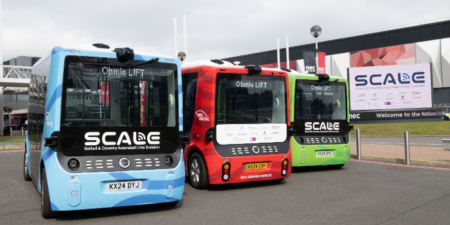A research team at the Georgia Institute of Technology team has devised a method of helping to keep a driverless vehicle under control as it maneuvers at the edge of its handling limits. The approach could help to make self-driving cars of the future safer under hazardous road conditions.
Researchers from Georgia Tech’s Daniel Guggenheim School of Aerospace Engineering (AE) and the School of Interactive Computing (IC) have assessed the new technology by racing, sliding, and jumping one-fifth-scale, fully autonomous model rally cars at the equivalent of 90mph (145km/h). The technique uses advanced algorithms and onboard computing, in concert with installed sensing devices, to increase vehicular stability while maintaining performance. The work, tested at the Georgia Tech Autonomous Racing Facility, is sponsored by the US Army Research Office. A paper outlining the research was presented at the recent International Conference on Robotics and Automation (ICRA), held on May 16-21.
The system has been developed to replicate the techniques used by a human rally-car driver when operating ‘on the edge’, whereas traditional robotic-vehicle techniques use the same control methods whether a vehicle is driving normally, or at the limits of roadway adhesion. The Georgia Tech method, known as model predictive path integral control (MPPI), was developed specifically to address the non-linear dynamics involved in controlling a vehicle near its friction limits.
The Georgia Tech researchers used a stochastic trajectory-optimization capability, based on a path-integral approach, to create their MPPI control algorithm. Using statistical methods, the team integrated large amounts of handling-related information, together with data on the dynamics of the vehicular system, to compute the most stable trajectories from myriad possibilities.
Processed by the high-power graphics processing unit (GPU) that the vehicle carries, the MPPI control algorithm continuously samples data coming from global positioning system (GPS) hardware, inertial motion sensors, and other sensors. The onboard hardware-software system performs real-time analysis of a vast number of possible trajectories and relays optimal handling decisions to the vehicle moment by moment. In essence, the MPPI approach combines both the planning and execution of optimized handling decisions into a single highly efficient phase. It is regarded as the first technology to carry out this computationally demanding task; in the past, optimal control data inputs could not be processed in real time.
The two model rally vehicles custom-built by the team use special electric motors to achieve the right balance between weight and power. The cars carry a motherboard with a quad-core processor, a potent GPU, and a battery. Each vehicle also has two forward-facing cameras, an inertial measurement unit, and a GPS receiver, along with sophisticated wheel-speed sensors. The power, navigation and computation equipment is housed in a rugged aluminum enclosure able to withstand violent rollovers. Each vehicle weighs about 48 lb (22kg) and is about 3ft (1m) long. The robot cars are able to test the team’s control algorithms without any need for off-vehicle devices or computation, except for a nearby GPS receiver. The onboard GPU lets the MPPI algorithm sample more than 2,500, 2.5-second-long trajectories in under 1/60 of a second.
“Aggressive driving in a robotic vehicle, maneuvering at the edge, is a unique control problem involving a highly complex system,” said Evangelos Theodorou, an AE assistant professor who is leading the project. “However, by merging statistical physics with control theory, and utilizing leading-edge computation, we can create a new perspective, a new framework, for control of autonomous systems.”
Click here to see a video of Georgia Tech’s testing procudure.
The latest research from around the world will be presented at the Autonomous Vehicle Test & Development Symposium. Click here to register.




